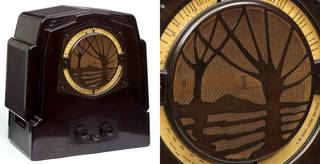From luxury handcrafted writing desks to affordable factory-made tea services, the evolution of the Art Deco movement, and its impact on home style, can be traced in our collections of furniture, fabrics, ceramics, metalware and glassware.
After the horrors of the First World War, furniture designers of the 1920s embraced notions of pleasure, glamour, luxury and escapism. They explored sumptuous surfaces and exotic materials, producing bespoke one-offs for the wealthy few. Emile Jaques Ruhlmann was regarded as a master of high-end, handcrafted interiors, best known for his elegant lines and exotic wood veneers. He referred to his richest creations as his 'precious pieces'.


Ruhlmann was one of the star exhibitors at the 1925 Paris Exhibition, a pivotal event in the development of the Art Deco style. The British contribution to the exhibition was limited, dismissed by critics as 'conservative', however a number of British textile companies were commended for their bright, modern furnishing fabrics, of which the V&A holds many dazzling examples.


Another stand-out British contribution was the shimmering writing desk, designed by British architect and designer, Sir Edward Maufe. The desk is handmade in mahogany with a lustrous white gold surface, exotic wood, ivory, rock and silk details – the epitome of Art Deco luxury.

At the daring edge of bespoke interior design, the Scandal Relief commissioned by Henry Mond, the second Lord Melchett, for the drawing room of Mulberry House, Westminster, London, made humorous reference to Mond's scandalous sexual liaisons. Designed by Charles Sargeant Jagger, the relief is important for its originality, symbolism and strong design. Along with its companion piece, the Melchett fire basket, it is a rare survivor from a significant Art Deco interior, which was sadly destroyed by air raids in 1940.

As the inter-war years advanced, emerging technologies and new materials created opportunities for designers to look beyond exclusive private commissions. John Skeaping was one of a number of artists who took an interest in bringing his work to the mass market. In 1927, he designed a series of small deer sculptures for Josiah Wedgwood and Sons.

The figures were highly successful, as they had broad appeal and their relatively simple forms allowed them to be made in one piece, using an inexpensive technique called slip-casting. This affordability allowed Skeaping's Art Deco aesthetic to enter more modest middle class homes.
In ceramics, Eric Slater's 'Vogue'-shaped bone-china tea sets, manufactured by the Shelley Potteries, were another commercial success. Their geometric form worked with a range of Art Deco designs, however, the novel conical cups and solid triangular handles came in for criticism. Some customers complained that the cups' wide-mouth allowed drinks to cool too quickly, and that they could not put a finger through the solid handle, nor hang the cups for storage.


After the Wall Street Crash, the luxury interior market was hard hit. The demand for inexpensive consumer goods increased, accelerating a move away from handcraft practice towards a modern aesthetic compatible with new materials and industrial production. Denham Maclaren's striking zebra armchair straddled the change. Maclaren made innovative use of industrial glass and metal fittings, but the zebra skin upholstery retains an exotic, sumptuous touch, with the overall effect being playful, almost Surrealist.

Chromed steel, aluminium, mirror, coloured glass and the new plastics – such as Bakelite and Catalin – became the favoured materials of the 1930s, replacing exotic woods, ivory and sharkskin. Inexpensive and adaptable, they could emulate the sensuous surfaces typical of 1920s Art Deco, but were suited to mass production – something that radio designers and manufacturers eagerly exploited. Radios became commonplace in domestic settings and the Art Deco style was popular for these small, decorative items. Bakelite allowed exciting, complex shapes to be moulded in a high-speed industrial process.

By the mid 1930s, the increased use of electric convector heaters provided opportunities for modern designers. Charles Barman's eye-catching design has four tiers to deflect warm air down and out. Its decorative effect is dependent not upon applied ornament but on its shiny, reflective surfaces and curvilinear, streamlined form, typical of the Art Deco aesthetic popularised in the United States.

As the Second World War broke out, Art Deco furnishings fell out of favour and were replaced by the functional, unadorned aesthetic of Modernism. Preserved within our collections, however, their strength, exuberance, optimism and beauty still continue to captivate the contemporary eye.


